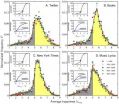(Press-News.org) No less than one third of a car's fuel consumption is spent in overcoming friction, and this friction loss has a direct impact on both fuel consumption and emissions. However, new technology can reduce friction by anything from 10% to 80% in various components of a car, according to a joint study by VTT Technical Research Centre of Finland and Argonne National Laboratory (ANL) in USA. It should thus be possible to reduce car's fuel consumption and emissions by 18% within the next 5 to 10 years and up to 61% within 15 to 25 years.
There are 612 million cars in the world today. The average car clocks up about 13,000 km per year, and in the meantime burns 340 litres of fuel just to overcome friction, costing the driver EUR 510 per year.
Of the energy output of fuel in a car engine, 33% is spent in exhaust, 29% in cooling and 38% in mechanical energy, of which friction losses account for 33% and air resistance for 5%. By comparison, an electric car has only half the friction loss of that of a car with a conventional internal combustion engine.
Annual friction loss in an average car worldwide amounts to 11,860 MJ: of this, 35% is spent in overcoming rolling resistance in the wheels, 35% in the engine itself, 15% in the gearbox and 15% in braking. With current technology, only 21.5% of the energy output of the fuel is used to actually move the car; the rest is wasted.
Worldwide savings with new technology
A recent VTT and ANL study shows that friction in cars can be reduced with new technologies such as new surface coatings, surface textures, lubricant additives, low-viscosity lubricants, ionic liquids and low-friction tyres inflated to pressures higher than normal.
Friction can be reduced by 10% to 50% using new surface technologies such as diamond-like carbon materials and nanocomposites. Laser texturing can be employed to etch a microtopography on the surface of the material to guide the lubricant flow and internal pressures so as to reduce friction by 25% to 50% and fuel consumption by 4%. Ionic liquids are made up of electrically charged molecules that repel one another, enabling a further 25% to 50% reduction in friction.
In 2009, a total of 208,000 million litres of fuel was burned in cars worldwide just to overcome friction; this amounts to 7.3 million TJ (terajoules) of energy. Theoretically, introducing the best current technological solutions in all of the world's cars could save EUR 348,000 million per year; the best scientifically proven solutions known today could save EUR 576,000 million per year, and the best solutions to emerge over the next 10 years could save EUR 659,000 million per year.
Realistically, though, over a period of 5 to 10 years of enhanced action and product development measures could be expected to enable savings of 117,000 million litres in fuel consumption per year, representing an 18% reduction from the present level. Furthermore, in realistic terms, carbon dioxide emissions could be expected to decrease by 290 million tonnes per year and financial savings to amount to EUR 174,000 million per year in the short term.
Drivers can influence fuel consumption
A driver can significantly influence the fuel consumption of his or her car. A reduction of 10% in driving speed, e.g. from 110 km/h to 100 km/h, translates into a 16% saving in fuel consumption. Slower speeds also allow for higher tyre pressures; an increase from 2 bar to 2.5 bar can translate into a 3% saving in fuel consumption.
VTT and ANL calculated friction loss in cars worldwide using a method that incorporated total crude oil consumption and fuel consumption of cars, the energy consumption of an average car, and the energy that an average car uses to overcome friction.
Friction losses were accounted for in the subsystems of a car – tyres, engine, gearbox, brakes – and also in its components, such as gears, bearings, gaskets and pistons. The friction losses caused at friction points and lubrication points were also considered.
The study was conducted at the Metal Products and Mechanical Engineering strategic competence cluster in the DEMAPP programme, co-ordinated by FIMECC Oy, where practical solutions for minimising friction loss are also being developed. The study was funded by the Finnish Funding Agency for Technology and Innovation (Tekes), VTT and FIMECC Oy, and the Argonne National Laboratory, Department of Energy (Chicago, USA).
The recent research report on friction loss in cars and the potential for reducing energy consumption and carbon dioxide emissions was published in the Tribology International scientific journal. The article can be accessed here: http://dx.doi.org/10.1016/j.triboint.2011.11.022
INFORMATION:
For more information, please contact:
VTT Technical Resarch Centre of Finland
Research Professor
Kenneth Holmberg
Tel. +358 40 544 2285
kenneth.holmberg@vtt.fi
Argonne National Laboratory, USA
Ali Erdemir
Argonne Distinguished Fellow
Tel. +1 630 853 1363
erdemir@anl.gov
Further information about VTT
Olli Ernvall, Senior Vice President, Communications
Tel. +358 20 722 6747
olli.ernvall@vtt.fi
www.vtt.fi
END
Mothers who take anti-depressants during pregnancy are more likely to give birth to children with persistent pulmonary hypertension (high blood pressure in the lungs) finds a study published today on bmj.com.
Persistent pulmonary hypertension is an increase in blood pressure in the lungs leading to shortness of breath and difficulty breathing. It is a rare, but severe disease with strong links to heart failure.
The study, carried out by researchers at the Centre for Pharmacoepidemiology at Karolinska Institutet in Stockholm Sweden, reviewed 1.6 million births in total ...
It is time to leave apart the belief that mass media are always a source of bad habits. Television, newspaper and the Internet, when used to get information, may turn out to be of help for health.
It is the conclusion of a study conducted by the Research Laboratories at the Fondazione di Ricerca e Cura "Giovanni Paolo II" in Campobasso which analyzed data from a sample of more than 1,000 people from the largest Moli-sani Project, the epidemiological study that recruited 25,000 subjects in Molise, a southern region of Italy.
The report, published on line in the International ...
Researchers from the Georgia Institute of Technology and the Centers for Disease Control and Prevention (CDC) have developed a new laboratory test that can rapidly identify the bacterium responsible for staph infections. This new test takes advantage of unique isotopic labeling combined with specific bacteriophage amplification to rapidly identify Staphylococcus aureus.
Quickly and accurately detecting infections caused by S. aureus is critical because the pathogenic bacterium causes a broad spectrum of infections, ranging from acute to chronic disease, which need to ...
Physicists at Linköping University have shown that a dose of hydrogen or helium can render the "super material" graphene even more useful.
Graphene has engendered high expectations whereof its extreme properties depend on the fact that it consists of a single sheet of carbon atoms. However the attraction forces between the atoms cause the sheets to be drawn to each other. One solution is to add atomic hydrogen between the layers.
Presented in the eminent journal Physical Review A, the researchers' calculations show that the hydrogen at a given concentration affects ...
Thousands more American senior citizens with kidney disease are good candidates for transplants and could get them if physicians would get past outdated medical biases and put them on transplant waiting lists, according to a new study by Johns Hopkins researchers.
The Hopkins investigators estimate that between 1999 and 2006, roughly 9,000 adults over 65 would have been "excellent" transplant candidates and approximately 40,000 more older adults would have been "good" candidates for new kidneys. None, however, were given the chance.
"Doctors routinely believe and tell ...
New Orleans, LA – A study led by Russell R. Russo, MD, a third-year Orthopaedic Surgery resident at LSU Health Sciences Center New Orleans School of Medicine, has identified a new source of life-threatening necrotizing fasciitis – "bath salts." The study, describing the first known case of necrotizing fasciitis from an intramuscular injection of the street drug known as "bath salts," is published in the January 2012 issue of Orthopedics, now available online.
Necrotizing fasciitis is an orthopedic emergency. The ability to quickly and accurately diagnose this rapidly ...
TORONTO, Ont., Jan. 12, 2012—Researchers at St. Michael's Hospital have published the first detailed figures showing the risk of using the prescription drug Rasilez in combination with certain other blood pressure-lowering medications.
The pharmaceutical company Novartis terminated a large, international clinical trial of the drug last month after finding an increased incidence after 18-24 months of non-fatal strokes, renal complications, high levels of potassium in the blood and low blood pressure.
As a result, Health Canada said on Dec. 22 that it would review the ...
A new study published in the journal Nature Medicine by NYU Cancer Institute researchers, shows how the cancer causing gene Notch, in combination with a mutated Polycomb Repressive Complex 2 (PRC2) protein complex, work together to cause T- cell acute lymphoblastic leukemia (T-ALL).
T-ALL is an aggressive blood cancer, predominately diagnosed in children. It occurs when one lymphoblast, an immature white blood cell, turns malignant, multiplying uncontrollably and spreading rapidly throughout the body. If left untreated, the disease can be fatal in a few weeks. Cancer-causing ...
WEST LAFAYETTE, Ind. - Honeybee populations have been in serious decline for years, and Purdue University scientists may have identified one of the factors that cause bee deaths around agricultural fields.
Analyses of bees found dead in and around hives from several apiaries over two years in Indiana showed the presence of neonicotinoid insecticides, which are commonly used to coat corn and soybean seeds before planting. The research showed that those insecticides were present at high concentrations in waste talc that is exhausted from farm machinery during planting.
The ...
"If it bleeds, it leads," goes the cynical saying with television and newspaper editors. In other words, most news is bad news and the worst news gets the big story on the front page.
So one might expect the New York Times to contain, on average, more negative and unhappy types of words — like "war," " funeral," "cancer," "murder" — than positive, happy ones — like "love," "peace" and "hero."
Or take Twitter. A popular image of what people tweet about may contain a lot of complaints about bad days, worse coffee, busted relationships and lousy sitcoms. Again, it might ...

